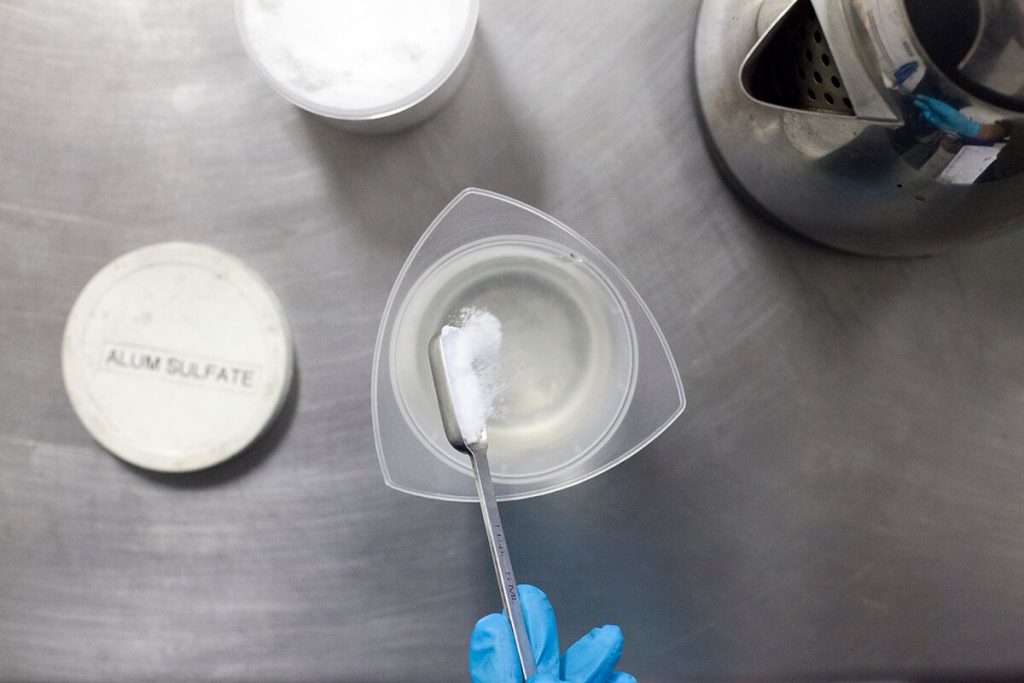
We get mordant questions all the time at Botanical Colors so why not create Mordant Monday??? Got mordanting questions? Email [email protected]
What is Mordanting?
Mordanting is the most important process of preparing fibers to accept color. Using a mordant helps to ensure the most durable and long-lasting colors. With the exception of indigo (as a vat dye, it does not require a mordant), this is not an optional step. However, there are many different mordants you can use. Deciding which mordant to use comes down to the types of fibers you want to dye and how much time or energy you wish to spend. The table we have on this page breaks down the different mordants that we sell and the advantages and disadvantages of each one.
YOU ASKED: I have tried the recipe for mordanting with Alum Sulfate, but I am not sure if its save to depose it down the drain. I’ve read that its ok to do this as long as the drain does not come out in a waterway, but if I look online I can only find lab-like sites saying alum should be disposed as a hazardous material and shouldn’t be poured down the drain. Can you help me out with how to safely dispose of alum and what research or backup information you base this on?
KATHY ANSWERED: Aluminum sulfate is commonly used in wastewater treatment, which is why we state that it can be disposed of in municipal water treatment systems. It is toxic to aquatic life, which is why it cannot be disposed of in a waterway or lake. If you are mordanting, your choices are to save the mordant and re-use it or to dispose of it. If your local government forbids the disposal then you need to dispose of it through hazardous or chemical handling sites. Otherwise, if there is no regulation forbidding its disposal, it can be disposed of in the municipal system.
YOU ASKED: I keep getting mixed answers from people about dyeing with plants from my yard and whether I need to mordant or not when using them. Advice?
KATHY ANSWERED: I think some of the confusion arises over what plant we’re talking about. Many plants contain high levels of tannins and these can be used to mordant and dye in one step, rather than using the traditional mordant method with aluminum sulfate or aluminum acetate.
Traditional tannin mordants include:
Common garden and kitchen tannins include:
- Tea
- Coffee
- Oak leaves, bark and acorns
- Sumac berries
- Walnut leaves, hulls, bark
- Other deciduous tree leaves and bark
So when you see someone explaining that they mordanted with oak gall tannin and no mention of alum, what they are saying is that they are using the natural plant tannins to mordant their fiber. Additionally, the plant mordant also usually dyes the fabric while mordanting, so you get both the advantages of a plant mordant and a color from the plant. If you have plants in your yard that are high in tannin, then yes, it is indeed possible to mordant and dye using only the plants. The real fun starts if you decide to add a metallic mordant, such as iron to your tannin-based mordant bath. Suddenly you will get dark shades from the iron and tannin reaction. If you decide to first mordant in tannin, then mordant in alum, you will find that often the dye color from the plant is brighter. After all this mordanting, you can then apply a dyestuff such as madder or weld or lac to the fibers and get beautiful, rich shades.
The other difference you may observe over time is between the durability and lightfastness when using a metallic mordant salt, such as alum versus using a tannin alone. Typically, the metallic mordants increase wash and lightfastness when used in combination with plant tannins.
My advice to you is to create a detailed list of the plants and their parts you are using. Note if it performs well as a plant mordant, or if you get better results from adding iron as a post-mordant, or alum as a post-mordant. It should super interesting to see how the colors change depending on the mordant you’ve used.
